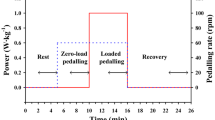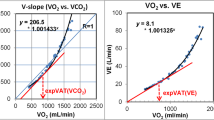Abstract
The aim of this study was to compare computerized automatic methods to detect the ventilatory threshold (VT). Thirty apparently healthy and physically active volunteers [22.5 (6.5) years; 1.72 (0.08) m; 71.9 (8.5) kg] were submitted to a progressive and maximal cycle exercise. The gas exchange was monitored breath-by-breath with a fast gas analyser. The VT and respiratory compensation (RC) were automatically detected based on the respiratory exchange ratio, the ventilatory equivalent for O2 and the ventilatory equivalent for CO2, pulmonary ventilation, end-tidal PO2 and PCO2, and v-slope. In addition, VT and RC were also determined independently by visual inspection by two experienced investigators, and the results were compared with those of the automatic procedures. The automatic VT averaged 77% of the maximal V̇O2 and the RC 88%. The agreement between the experienced observers was very close [mean difference: 44.4 (16.1) ml, r=0.94, not significant]. Data were expressed as the mean value together with the standard deviation in each case. The automatic and visual inspection procedures did not present significant differences, resulting in 29.6 (29.6) ml with a reliability of r=0.86. All methods were significantly correlated for VT and RC (r=0.93 on average, P<0.01). ANOVA did not show differences between either the VT methods (P=0.131) or the RC methods (P=0.41). In conclusion, the present study has compared several simultaneous breath-by-breath ergospirometric methods that are used to describe the anaerobic threshold, showing high confidence when compared to visual inspection. No statistical differences were found between the VT and RC techniques for physically active subjects indicating that these methods may be equally effectively employed.




Similar content being viewed by others
References
Abreu MG, Melo MF, Giannella-Neto A (2000) Pulmonary capillary blood flow by partial CO2 rebreathing: importance of the regularity of the respiratory pattern. Clin Physiol 20:388–398
Beaver WL, Wasserman K, Whipp BJ (1986) A new method for detecting the anaerobic threshold by gas exchange. J Appl Physiol 60:2020–2027
Bergman BC, Brooks GA (1999) Respiratory gas-exchange ratios during graded exercise in fed and fasted trained and untrained men. J Appl Physiol 86:479–487
Billat LV (1996) Use of blood lactate measurements for prediction of exercise performance and for control of training. Sports Med 22:157–175
Bland JM, Altman DG (1986) Statistical methods for assessing agreement between two methods of clinical assessment. Lancet 1:307–310
Brooks GA (1985) Anaerobic threshold: review of the concept and direction for future research. Med Sci Sports Exerc 4:31–35
Brooks GA (2000) Intra- and extra-cellular lactate shuttles. Med Sci Sports Exerc 32:790–799
Caiozzo VJ, Davis JA, Ellis JF, Azus JL, Vandagriff R, Prietto CA, McMaster WC (1982) A comparison of gas exchange indices used to detect the anaerobic threshold. J Appl Physiol 53:1184–1189
Coyle EF, Coggan AR, Hopper MK (1988) Determinants of endurance in well-trained cyclists. J Appl Physiol 64:2622–2630
Davis HA, Gass GC (1981) The anaerobic threshold as determined before and during lactic acidosis. Eur J Appl Physiol 47:141–149
Davis JA, Vodak P, Wilmore JH, Vodak J, Kurtz P (1976) Anaerobic threshold and maximal aerobic power for three modes of exercise. J Appl Physiol 41:544–550
Davis JA, Whipp BJ, Lamarra N, Huntsman DJ, Frank MH, Wasserman K (1982) Effect of ramp slope on measurement of aerobic parameters from the ramp exercise test. Med Sci Sports Exerc 14:339–343
Demarle AP, Slawinski JJ, Laffite LP, Bocquet VG, Koralsztein JP, Billat VL (2001) Decrease of O2 deficit is a potential factor in increased time to exhaustion after specific endurance training. J Appl Physiol 90:947–953
Dickstein K, Barvik S, Aarsland T, Snapinn S, Karlsson J (1990) A comparison of methodologies in detection of the anaerobic threshold. Circulation 81[Suppl II]:II38–II46
Fleg JL, Pina IL, Balady GJ, Chaitman BR, Fletcher B, Lavie C, Limacher MC, Stein RA, Williams M, Bazzarre T (2000) Assessment of functional capacity in clinical and research applications: An advisory from the Committee on Exercise, Rehabilitation, and Prevention, Council on Clinical Cardiology, American Heart Association. Circulation 102:1591–1597
Fletcher WM, Hopkins FG (1907) Lactic acid in amphibian muscle. J Physiol 35:247–309
Formanek D, Wanke HL, Lahrmann H, Rauscher H, Popp W, Zwick H (1993) Inspiratory muscle performance relative to the ventilatory threshold in healthy subjects. Med Sci Sports Exerc 25:1120–1125
Foster VL, Humf GJE, Dickinson AL, Chatfield SJ, Byrnes WC (1986) The reproducibility of V̇O2max, ventilatory, and lactate thresholds in elderly women. Med Sci Sports Exerc 18:425–430
Gaesser GA, Poole DC (1986) Lactate and ventilatory thresholds: disparity in time course of adaptations to training. J Appl Physiol 61:999–1004
Gaskill SE, Ruby BC, Walker AJ, Sanchez GA, Serfass RC, Leon AS (2001) Validity and reliability of combining three methods to determine ventilatory threshold. Med Sci Sports Exerc 33:1841–1848
Hill AV, Long CNH, Lupton H (1924) Muscular exercise, lactic acid and the supply and utilization of oxygen. Proc R Soc Lond B Biol Sci 96:438–475
Ivy JL, Withers RT, Van Handel PJ, Elger DH, Costill DL (1980) Muscle respiratory capacity and fiber type as determinants of the lactate threshold. J Appl Physiol 48:523–527
Kinderman W, Simon G, Keul J (1979) The significance of the aerobic-anaerobic transition for the determination of workload intensities during endurance training. Eur J Appl Physiol Occup Physiol 42:25–34
Mader A (1991) Evaluation of the endurance performance of marathon runners and theoretical analysis of test results. J Sports Med Phys Fitness. 33:1–19
Margaria R, Cerretelli P, Mangili F (1963) Balance and kinetics of anaerobic energy release during strenuous exercise in man. J Appl Physiol 19:623–628
McDougall JD, Wenger HA, Green H (1983) The physiological testing of the elite athlete. Mutual, Ottawa
McLellan TM (1985) Ventilatory and plasma lactate response with different exercise protocols: a comparison of methods. Int J Sports Med 6:30–35
Neary PJ, MacDougall JD, Bachus R, Wenger HA (1985) The relationship between lactate and ventilatory thresholds: coincidental or cause and effect? Eur J Appl Physiol 54:104–108
Orr GW, Green HJ, Hughson RL, Bennett GW (1982) A computer linear regression model to determine ventilatory anaerobic threshold. J Appl Physiol 52:1349–1352
Poole DC, Gaesser GA (1985) Response of ventilatory and lactate thresholds to continuous and interval training. J Appl Physiol 58:1115–1121
Posner JD, Gorman KM, Klein HS, Cline CJ (1987) Ventilatory threshold: measurement and variation with age. J Appl Physiol 63:1519–1525
Powers SK, Dodd S, Gardner R (1984) Precision of ventilatory and gas exchange alterations as a predictor of the anaerobic threshold. Eur J Appl Physiol 52:173–177
Schneider DA, Phillips SE, Stoffano S (1993) The simplified v-slope method of detecting the gas exchange threshold. Med Sci Sports Exerc 25:1180–1184
Sherrill DL, Anderson SJ, Swanson G (1990) Using smoothing splines for detecting ventilatory thresholds. Med Sci Sports Exerc 22:684–689
Thomas JR, Nelson JK (1996) Research methods in physical activity, 4th edn. Human Kinetics, Champaign, Ill.
Wasserman K, McLlroy MB (1964) Detecting the threshold of anaerobic metabolism in cardiac patients during exercise. Am J Cardiol 14:844–852
Wasserman K, Hansen JE, Sue DY, Whipp BJ, Casaburi R (1999) Principles of exercise testing and interpretation, 3rd edn. Lea & Febiger, Philadelphia, pp17–61, 153–154
Whipp BJ, Davis JA, Torres F, Wasserman K (1981) A test to determine parameters of aerobic function during exercise. J Appl Physiol 50:217–221
Yoshida T, Suda Y, Takeuchi N (1982) Endurance training regimen based upon arterial blood lactate: effects on anaerobic threshold. Eur J Appl Physiol 49:223–230
Acknowledgements
The present work was partially supported by grants from the Brazilian Research Council, CNPq, FINEP and FAPERJ. The authors would like to thank all volunteers who contributed to this work, and Dr. Ian V. Silva for his appraisal of the manuscript.
Author information
Authors and Affiliations
Corresponding author
Rights and permissions
About this article
Cite this article
Santos, E.L., Giannella-Neto, A. Comparison of computerized methods for detecting the ventilatory thresholds. Eur J Appl Physiol 93, 315–324 (2004). https://doi.org/10.1007/s00421-004-1166-6
Accepted:
Published:
Issue Date:
DOI: https://doi.org/10.1007/s00421-004-1166-6




